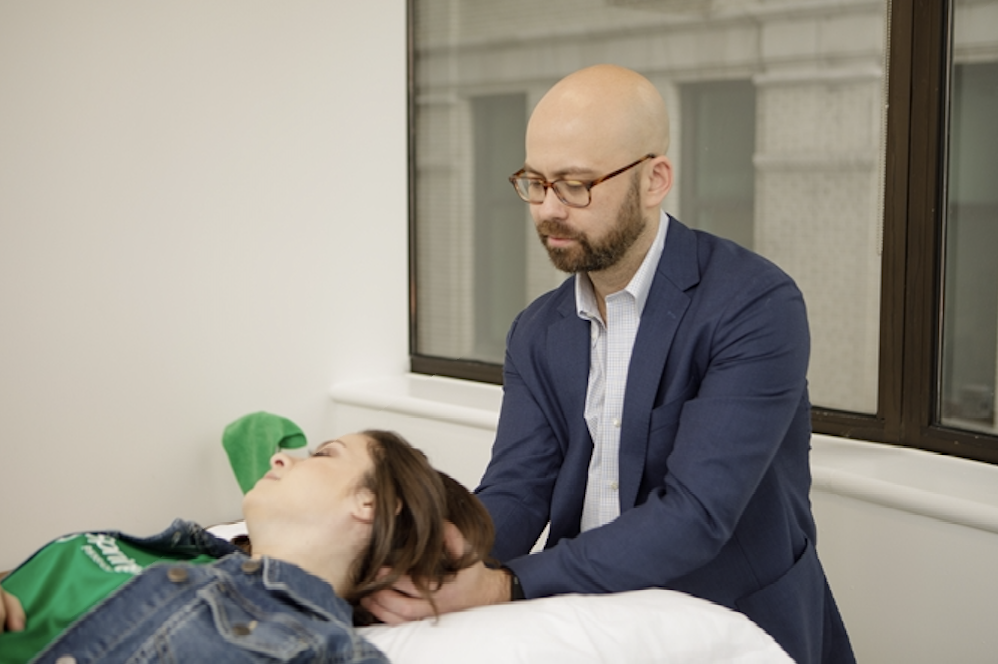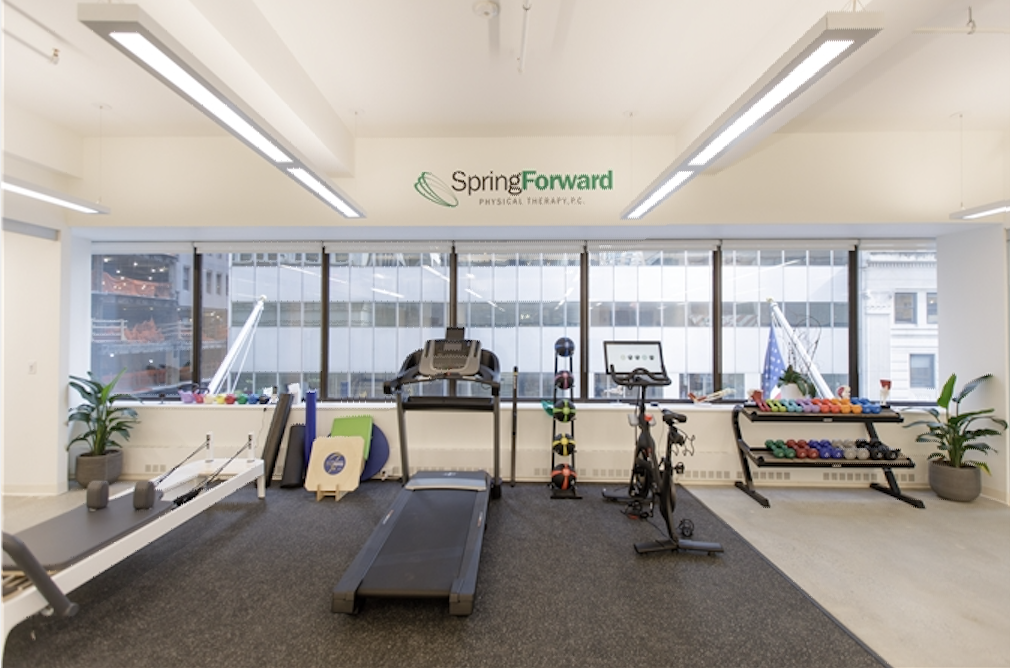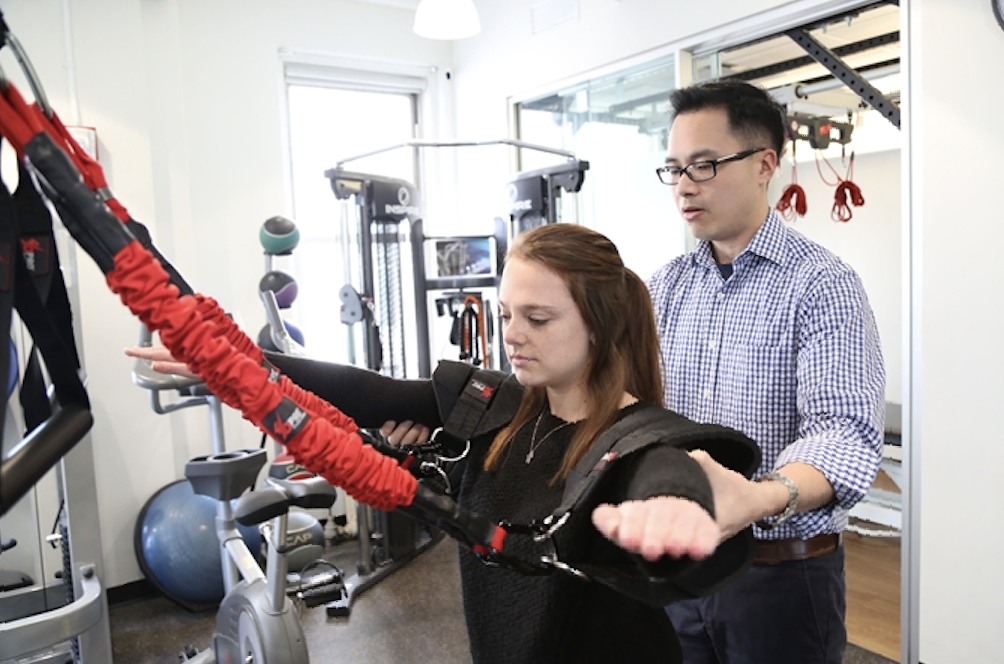Orthopedic Physical Therapy
How Do You Go About Preventative Surgery/Normal Physical Therapy?
At Spring Forward Physical Therapy patients receive personalized care that is tailored specifically to their condition, needs, and goals. Each patient’s presentation is unique and our approach to treatment evaluates the root cause of the injury. We aim to correct the underlying dysfunction, in addition to treating the patient’s pain, ensuring that they will remain well in the future. All sessions are completely one on one with a doctor of physical therapy.
During the initial evaluation, a patient’s biomechanics and movement patterns (how they move), range of motion (how much they move), strength, stability, muscular flexibility, posture, and joint mobility are assessed. We provide a whole-body approach, examining not just the region of pain but the joints and tissues of the surrounding body parts to determine if/how they are contributing to the condition. Our doctors of physical therapy use this information to create a completely individualized plan of care for each patient. A variety of advanced techniques are then utilized for treatment, including manual therapy (hands-on treatment), custom therapeutic exercise, and neuromuscular re-education, and response to treatment is measured at each session. Patients are seen by the same therapist each session to ensure continuity of care, making sure the patient is responding to therapy and showing improvements.
Manual therapy techniques are treatments that are provided hands-on to muscles, fascia, and joints. This includes soft tissue massage and mobilization, myofascial release, joint mobilization, trigger point therapy, muscle energy techniques, joint manipulation, stretching, passive/active assisted range of motion, active release technique, proprioceptive neuromuscular facilitation (PNF) and more. Manual therapy aids in restoring muscles, fascia, and joints back to their typical, pre-injury state and provides the backbone upon which therapeutic exercise and neuromuscular re-education are applied.
Therapeutic exercises are specifically selected by the doctor of physical therapy based on the patient’s condition, injury presentation, abilities, and goals. This includes exercises that focus on building strength, creating stability, improving muscular control, and range of motion. Exercises selected can be replicated at home with the use of body weight, light weights and/or provided bands, making sure that patients can perform them on a daily basis without the need of a gym. We focus on utilizing exercises that are functional, meaning they promote strength in common motions that translate into everyday life, preparing the body for activities the patient frequently encounters. All patients are prescribed a home exercise program to continue outside of PT sessions.
Neuromuscular Re-education is a way of re-training the muscles, nerves, and brain so that they can better communicate and act cohesively to improve how a person moves. Patients with injuries often present with poor or inefficient movement patterns and sub-optimal muscle recruitment (calling in too many or too few muscles to help with a movement.) Neuromuscular re-education focuses on training both simple and complex movement activities that combine strength, stability, proprioception, and range of motion. We make sure that all systems work together to promote efficiency during tasks like posture, gait, and balance.
Throughout treatment, the doctor of physical therapy works closely with the patient’s medical team and will provide their medical doctor with periodic updates. Spring Forward Physical Therapy’s elite and personalized care allows patients to bounce back faster and better than ever!

How Do You Go About Pre-Surgery “Prehab” Physical Therapy?
“Prehab” is a term used to describe physical therapy that takes place BEFORE a surgical procedure. By addressing restrictions and limitations in muscles, connective tissue, and joints PRIOR to surgery, studies show that patients will exhibit improved outcomes and quicker recovery following their surgical procedure. Patients also have the opportunity during this time to learn about what their upcoming surgery entails and how to prepare themselves, their caretakers, and their home environment for the recovery process. Spring Forward Physical Therapy provides the essential personal touch needed to treat pre-surgical patients. Because our doctors of physical therapy work one on one we consider each patient’s current presentation as well as their future post-surgical goals to build customized pre-surgical “prehab” treatment plans.
During the initial evaluation, a patient’s biomechanics and movement patterns (how they move), range of motion (how much they move), strength, stability, muscular flexibility, posture, and joint mobility are assessed. We provide a whole-body approach, examining not just the region of pain but the joints and tissues of the surrounding body parts to determine if/how they are contributing to the condition. A variety of advanced techniques are then utilized for treatment, including manual therapy (hands-on treatment), custom therapeutic exercise, and neuromuscular re-education.
The patient goes on to complete their individualized prehab program to establish an excellent foundation for surgery, ensuring a quicker, better recovery.
How Do You Go About Post-Surgery Physical Therapy?
Patients often present to physical therapy to begin a rehabilitation program in the initial days or within the first few weeks after surgery. At Spring Forward Physical Therapy, we work hard to help patients achieve their post-surgical goals, whether they are to climb two flights of their apartment walk-up or, hike the Swiss Alps, or return to professional sports. Our doctors of physical therapy treat post surgical patients with rehabilitation programs individualized to their personal needs and abilities. We work closely with the medical doctors and surgeons, updating the doctor periodically and always before medical appointments to ensure the patient achieves their desired goals.
Our doctors of physical therapy work one on one and the patient is seen by the same physical therapist at each session to ensure continuity of care. During the initial evaluation a patient’s biomechanics and movement patterns (how they move), range of motion (how much they move), strength, stability, muscular flexibility, posture, and joint mobility are assessed. The surgical site is also evaluated for healing, swelling and scar tissue.
Early post-surgical treatment focuses on reducing inflammation, promoting healing, brace/assistive device management, and re-introducing modified functional mobility. This phase typically includes manual therapy for edema and swelling reduction, gentle soft tissue mobilization and joint mobilization, light stretching and ROM building, isometric and gentle isotonic strengthening, and modalities for pain relief. The focus will then shift to improving range of motion and soft tissue quality back to normal, increasing strength and stability, and discharging braces or assistive devices.
We will continue to work on promoting improved biomechanics to optimize mobility and function. Lastly, we focus on return to full function and previous activities and ridding the body of any compensatory movement patterns. This may include advanced strengthening, balance training, proprioceptive training, plyometrics, and return to sport programming. As patients progress through rehabilitation their program changes, continuously building upon their gains and always working to achieve their goals.

What Is Your Take On Manual Therapy And How Is It Used At Spring Forward PT?
Manual therapy techniques are treatments that are provided hands on to muscles, tendons, ligaments, fascia, and joints. This includes soft tissue massage and mobilization, myofascial release, joint mobilization, trigger point therapy, muscle energy techniques, joint manipulation, stretching, passive/active assisted range of motion, active release technique, proprioceptive neuromuscular facilitation (PNF) and more.
Manual therapy aids in restoring the soft tissue and joints back to their typical pre-injury state. It helps to decrease pain, improve joint range of motion, increase soft tissue length, texture and mobility, promote stability, as well as to reduce inflammation and swelling. It provides the backbone upon which therapeutic exercise and neuromuscular re-education are applied. Manual therapy is an essential part of a comprehensive physical therapy treatment and our doctors of physical therapy are trained in a multitude of advanced manual therapy techniques.
What Is Your Take On Cold Laser Treatment And How Is It Used At Spring Forward PT?
At Spring Forward Physical Therapy, we offer Cold Laser Therapy (also known as LLLT, low-level light therapy.) Cold Laser uses light energy at various wavelengths depending on the purpose needed and the injury being treated. The light energy promotes a photochemical reaction which increases cellular metabolism. This will expedite cell repair by creating more ATP and it stimulates the immune, lymphatic, nervous and circulatory system. The benefit that Cold Laser Therapy has is the depth that it can penetrate. Research has shown that Cold Laser can penetrate over 5 centimeters, which is more than 2 inches. This is perfect for getting into joint spaces of great depth and deeper into fleshy tissue. Unlike with Ultrasound, the speckle field created allows for the tissue to affect the entire depth of penetration. This makes it very efficient and effective.
Cold Laser alone has shown to help reduce scar tissue, inflammation, adhesions, and pain. It also will create more cell activity to increase the speed of recovery in most cases. When used in addition to our PT treatments, we are giving our patients the best chance to recover fully. Cold Laser is just one of the many tools we use to stay up to date with innovative technology when it comes to patient care.
What Is Your Take On Pilates For Physical Therapy And How Is It Used At Spring Forward PT?
Pilates is a form of exercise that focuses on building strong, lean and toned muscles. Special attention is provided to the core, hips, and pelvic floor when participating in Pilates, with the goal of eliminating muscle imbalance and promoting flexibility and proximal muscle strength and stability. Pilates can be done without any equipment (mat Pilates), or it can be performed using specialized equipment. At Spring Forward, we utilize the Pilates Reformer and Tower apparatus during our treatment sessions. These machines work using springs to provide resistance or assistance with exercise.
Pilates is a great type of exercise to participate in when recovering from an injury or with managing acute and chronic musculoskeletal conditions. The intensity of the exercises can be scaled to meet the needs of each individual patient. Our techniques will aid in improving overall body awareness, movement and posture, as well as increasing muscular strength. After Pilates based sessions, Patients will also be provided with a “mat” based (aka equipment free) home exercise program that can be done in the comfort of their home, without the use of special equipment. We utilize Pilates as part of the rehabilitation process during PT sessions, but we are also available for private Pilates sessions.


